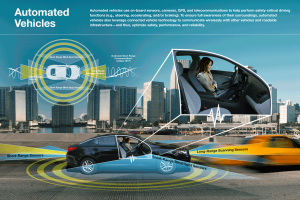Booz Allen and Cybersecurity
Darcy Conlin
Last week we ran an article about Booz Allen, a management and technology strategy consulting company based in the greater Washington DC. Driverless Transportation spoke to Dr. Christopher Hill, senior associate at the company and leader of the firm’s Intelligent Transportation System (ITS). Our previous article talked about connected vehicles. This week we will take a look at Booz Allen’s role with cyber security.
Booz Allen has a large cyber security practice across the firm overall but has a specific focus on the cyber security within the transportation industry. Dr. Hill shared that Booz Allen has been actively involved as part of the connected vehicle (CV) program to provide advice to the Joint Program Office (JPO) and the National Highway Traffic Safety Administration (NHTSA) on what would be an appropriate security and credential management system. Hill says, “We need something that would ensure there was a trusted environment between vehicles and also between the vehicles and the infrastructure. NHTSA has been working with carmakers to develop a technical design but hired us to do a couple of other things. One was to review that design and make recommendations.” Additionally, Hill said that Booz Allen has also done a cost analysis of the design. This was important to NHTSA to help them decide whether they were going to pursue rule making.
When asked where he sees this technology headed, Dr. Hill shared some interesting plans. “We have just recently completed writing the ITS JPO’s next ITS Strategic Plan for 2015-2019. So I think we have a lot of insight into where the JPO sees the connected vehicle program heading as a whole.” Hill believes there are two key aspects. The first is the CV program has completed most of its core research activities and the JPO views it as shifting into an adoption phase. ITS JPO is planning to initiate a series of connected vehicle pilot programs next year, and is also working closely with the Federal Highway Administration (FHWA) and other administrations that work with the actual deployers to develop implementation guidance. Hill states, “I think we can be very confident in what we’re seeing now is a shift from research to deployment. Certainly this is seen on the public sector side. And we know from the announcements that we’ve seen such as GM’s recent announcement at ITSWC, they are clearly taking the in-vehicle aspects of this phase seriously and many of them moving quite aggressively to see equipment in vehicles.” The second aspect Hill notes that is emerging from the new ITS Strategic Plan is the whole concept of connected automation. “I think the government is recognizing that the work on vehicle automation is progressing at pace within the industry so it’s time for the government to focus on what role will it play there.”
While the Strategic Plan doesn’t specifically prescribe what that role is going to be, it would appear that the JPO sees itself playing an active role in helping to facilitate that connection between the CV work and the emerging vehicle automation work. Perhaps with these projections it may be feasible to see early deployment the latter part of this decade. That appears to be the question that everyone is asking. When will we actually see this all come to fruition?
Along with Booz Allen’s role in advising the JPO with the Strategic Plan for the next five years, Hill says another area where he sees Booz Allen playing a major role is related to all of the data that will be generated from a connected vehicle environment. Booz Allen has devoted much time, energy and resources to understanding data science. They have even created a book on this topic called The Field Guide To Data Science. As stated on the website, Booz Allen developed this to help organizations of all types and missions understand how to make use of data as a resource. Specifically related to the connected vehicle industry, Dr. Hill says, “We’ve done a lot of work for the JPO over the past several years that has looked at data coming from some of the connected vehicle trials, such as the safety pilots in Ann Arbor.” Booz Allen has looked at how to sanitize, store and make that data available to researchers. This continues to be an area that has a massive amount of value in the industry.
Additionally, Booz Allen has recently started some new work with the JPO to look at how to use all the data that will be developed in future CV systems. They are developing a strategy for a real time operational environment that will be deployed as part of the SE Michigan test bed to show how agencies or others can start to use that data in their real time transportation operations activities.
While this is truly exciting news and seems to be pushing the development of our emerging CV forward, of course there are challenges. Although it was a good size pilot project, in reality the pilot was quite modest compared to the real picture of what connected vehicle deployment will look like in the future. Vast amounts of data will be generated. Which, according to Hill, “Is great on one hand, but also challenging when you are trying to analyze and manipulate it and use it in real time operational decisions.” Therefore Hill still sees some big technical challenges ahead and hopes to utilize Booz Allen’s very strong data analytics capabilities. The firm’s big data practice can help identify how to deal with what Hill calls “fire hoses of data” coming in. Their goal will be to make something useful to system operators in developing the proper technology.
In wrapping up our lively conversation with Dr. Hill, he shared his enthusiasm about being part of this evolving industry and the role he has played over the last 30 years. As a developer in the early deployment of electronic toll collection systems, along with the analysis of route guidance and navigation systems, Hill has evidently seen his share of budding technologies and advancements. Every day that he commutes into the DC area he gets to experience how broadly accepted and common those technologies have become as vehicles zip through the tolls and passengers utilize hand held GPS systems. We don’t even think about it. Hill remembers that 25-30 years ago his colleagues were asking “exactly the same questions about how people are going to accept these changes.” With the impressive history of Booz Allen’s support and its foundation, Hill feels confident that connected and subsequently automated vehicles are going to share the same transition and implementation path.


